What’s the most used fixture in your home? Is it the lights? The fans? The toilet, perhaps?
You probably won’t be surprised to hear this, but it’s none other than bathroom and kitchen faucets.
These fixtures are used several times a day, every day of the week.
While the basic functionality of both bathroom and kitchen faucets is the same, that is, providing water for tasks like washing the dishes, washing your hands, etc., they’re different in terms of appearance and usability.
You may think that both the type of faucets can be used interchangeably, but, as you’re going to find out in this blog post, that’s not the case.
Each type is designed to suit a certain type of sink and used in a specific manner.
If you want to know how bathroom and kitchen faucets differ from one another, you should give this blog post a read for an in-depth bathroom vs. kitchen faucets comparison.
How Do Bathroom Faucets and Kitchen Faucets Differ?
Size and Height
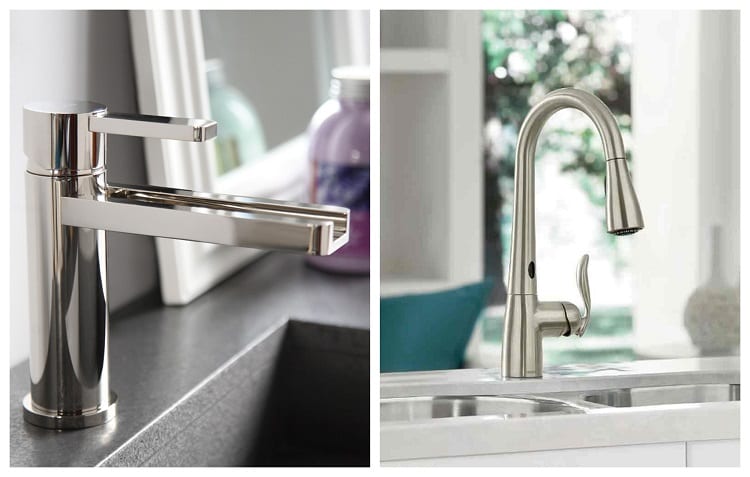
A bathroom faucet is slightly smaller than a kitchen faucet. Kitchen faucets have larger center sets as compared to bathroom faucets.
Kitchen faucets usually come with an 8-inch long center set, whereas bathroom faucets come with a 4-inch long center set.
Kitchen faucets also include numerous accessories like a hand sprayer and soap dispenser that aren’t found in bathroom faucets.
Arc Design
The arc of any faucet is not just an element to enhance the aesthetics, but it has a purpose to serve.
The arc of kitchen faucets is larger as compared to that of bathroom faucets.
The larger arc allows larger cooking vessels to fit comfortably under the water stream, hence enabling you to wash your dishes more efficiently.
Variety and Durability
You will come across a huge variety in both bathroom and kitchen faucets, but the variety is somewhat limited when it comes to bathroom faucets.
Kitchen faucets are available in more styles, curves, and textures are compared to bathroom faucets because they are used to enhance the overall aesthetics of the kitchen.
Bathroom faucets are more focused on utility and stability. They’re made with sturdy metals that ensure that they last for quite a long time.
Functionality
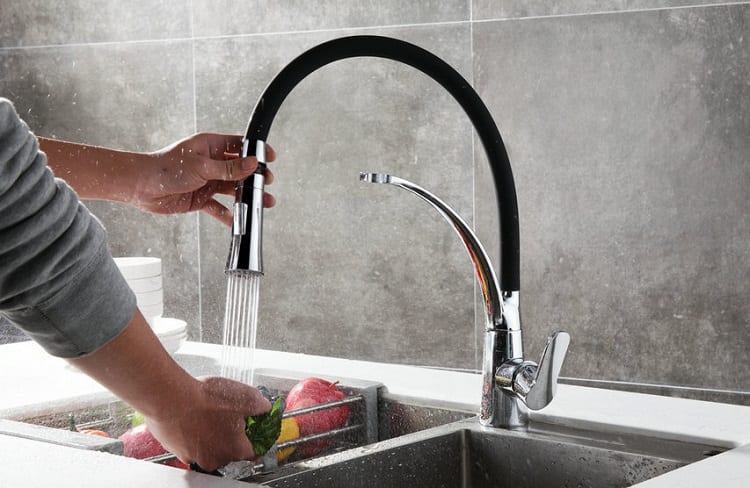
Kitchen faucets have the edge over bathroom faucets in terms of functionality.
While you won’t find bathroom faucets that have a flexible positioning feature, many models of kitchen faucets come with an incredible, 360-degree rotation, pull-down, elbow outlet, and many other features.
Newer models of kitchen faucets also have an option where you can change the water flow, which is an extremely handy feature when you’re washing dishes.
You can change the direction of a kitchen faucet and cover a wider surface, whereas most bathroom faucets do not offer any such options and are usually fixed in a single position.
Hence, the reach in bathroom faucets is quite limited. Bathroom and kitchen faucets also differ when it comes to aerators.
Bathroom faucets carry 3 to 4-inches of threading on them in general, which allows you to install other accessories like a hose.
However, kitchen faucets usually have decorative aerators only, which do not serve any real purpose.
Supply Line
Now, you might be wondering, “surely the supply line for both these faucets has got to be the same, right?”
Well, you’ll be surprised to know that there is a difference in supply lines for bathroom and kitchen faucets.
The difference isn’t very significant, but it does exist nevertheless.
Supply lines for bathroom faucets are made up of copper and are attached to the top of the faucet.
Sometimes, the supply lines are concealed under the wall and aren’t visible.
On the other hand, the supply lines for kitchen faucets are present on the bottom and are passed via holes in the sink.
These supply lines are not concealed and are present out in the open under the sink.
Therefore, you can switch-on or switch-off the flow of water with ease.
Installation
The installation of both bathroom faucets and kitchen faucets is complicated.
However, the installation of bathroom faucets is lengthier.
Bathroom faucet installation requires a lot of work in terms of sizing and construction.
In short, the whole process is quite complicated.
As for the installation of kitchen faucets, the process is simple and quick. In fact, you can install a kitchen faucet yourself.
Can You Use Kitchen Faucets in the Bathroom?
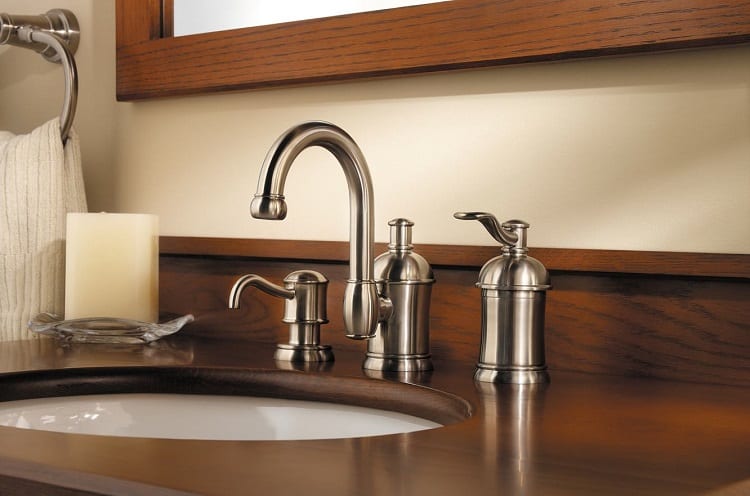
There’s no rule that says that you can’t use a kitchen faucet in the bathroom.
However, the kitchen faucet that you want to use in the bathroom should match the sink design in your bathroom.
If the design is a perfect match, you can install a kitchen faucet in the bathroom without any hitches in the fitting.
However, in case the design doesn’t match, you might have to modify the sink.
There are many types of kitchen faucets that are good to be used in a bathroom.
Wall-mounted faucets, single-handle faucets, and motion sensor faucets can be used in both the kitchen and bathroom.
Bathroom Faucets and Rust
Here’s where the shine comes off the faucets (quite literally).
Rusted bathroom faucets not only look unappealing, but they leave a negative impact on the overall appearance of your bathroom.
Rusting on bathroom faucets is very common.
The environment of the bathroom stays humid and moist most of the time, which provides ideal conditions for the faucets to rust.
Although the rusting of bathroom faucets may seem inevitable, there are some ways through which you can prevent it from happening in the first place.
Most commonly, bathroom faucets are chrome faucets that are prone to rusting.
As such, the best way to stop your chrome faucets from rusting is by doing away with them entirely and replacing them with stainless steel faucets.
Stainless steel faucets are rust-resistant.
Therefore, once you have these faucets installed in your bathroom, you won’t have to worry about rusting for a very long time.
However, if you do have chrome bathroom faucets and you aren’t planning on getting new stainless steel faucets installed any time soon, the below-mentioned tips on how to get rid of rust from bathroom faucets are going to help you a great deal!
Vinegar Spray
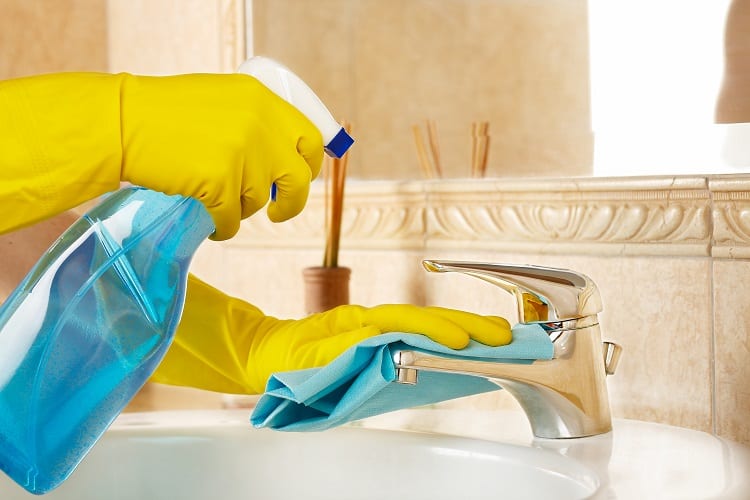
If your bathroom faucets have rusted, try spraying undiluted vinegar on the rust spots.
Let the vinegar sit for approximately 10 minutes and then scrub the faucets.
Vinegar dissolves the rust and helps you make your bathroom faucets look as shiny as new!
Treating your bathroom faucets with car wax after the vinegar treatment will help you prevent rust issues in the future.
Aluminum Foil
This technique of removing rust from bathroom faucets is unbelievably efficient!
Rubbing a loose aluminum ball on your rusted faucets can help you get rid of rust in no time.
All you have to do is make a loose ball of aluminum foil, dip it in water, and scrub your faucets.
If you think that the rust is quite stubborn and just water won’t do the job well enough, dip the aluminum foil ball in cola instead.
Cola contains carbonic acid that causes a chemical reaction with the iron oxide present in rust.
This causes the rust to break away from the faucets. For the final finishing, polish your bathroom faucet with a dry cloth.
The best part is yet to come. Aluminum foil helps you seal the chrome and protect it from future rusting.
Store-Brought Rust Solutions
You will come across numerous cleaners in the market that can help you get rid of rust and grime that usually forms on bathroom faucets.
To get rid of rust completely, you might have to scrub the rust spots a little.
The end results are shiny faucets that will make your bathroom look more visually appealing!
Tips to Prevent Rusting
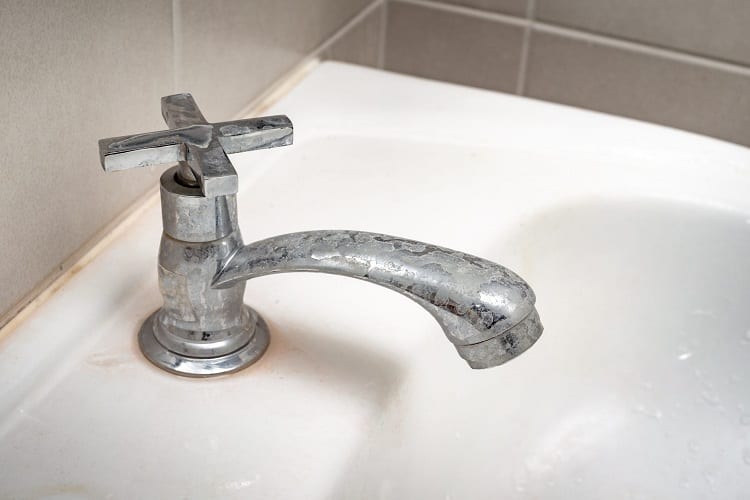
The rusting of bathroom faucets is common due to the moist and humid environment of the bathroom, the presence of iron traces in the water, and rust flecks from supply pipes.
However, being mindful about certain things can help you prevent the rusting of your bathroom faucets.
The majority of households use bleach-based cleaners to clean their bathrooms, but did you know that bleach can actually cause rust stains to set, thus making them more difficult to remove?
To prevent the rusting of your faucets, make sure that you don’t apply bleach-based cleaners on your faucets.
Abrasive sponges can also scratch the faucets and promote rust formation.
Therefore, you should avoid using scrubs or brushes that have abrasive bristles.
Steel wool is also known to cause the faucets to rust, as it removes the coating that protects the outer layer of the faucets.
Being mindful of your cleaning practices can help you prevent the rusting of your bathroom faucets and help you keep your bathroom looking at its best for the longest possible time.
Conclusion
This in-depth bathroom vs. kitchen faucets comparison is all you need to know about two types of faucets and how they differ from one another.
While there are some types of faucets that can be used in both the bathroom and kitchen, the specifications in terms of design, construction, and installation are different for both.
Installing the right type of faucet in the right place will ensure that you have the best fixture for the tasks at hand.
